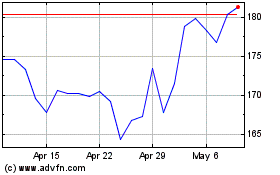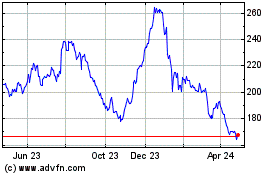Russian Arms Maker Preempts Dutch MH17 Report -- Update
October 13 2015 - 4:39PM
Dow Jones News
By Paul Sonne
MOSCOW--Russian state arms maker Almaz-Antey, producer of the
Buk missile system, welcomed hundreds of journalists to an
industrial park in outer Moscow on Tuesday, hours before Dutch
authorities released their final report on the crash of Malaysia
Airlines Flight 17.
The goal: To cast doubt on the Dutch probe's results before they
were even released. Slides, graphs and simulations were on offer.
Pieces of shrapnel decorated the stage. The arms maker even cued up
footage of an experiment conducted earlier this month, in which its
specialists blasted the cockpit of an Ilyushin 86 aircraft with a
Buk missile in a Russian field.
"The results of the experiment completely refuted the
conclusions of the Dutch commission on the type of missile and the
place of its launch," said Almaz-Antey Chief Executive Jan Novikov,
hours before the Dutch commission had released those
conclusions.
In short, attendees slipped through the Russian looking glass,
where information about MH17 consistently has opposed what most of
the rest of the world has come to believe about the downing of the
aircraft. Almaz-Antey's presentation was then beamed across the
country as the lead story in state newscasts, bringing the
alternative reality to Russian homes.
Since the July 2014 disaster, Russia's government, state media
and main investigative body have advanced various arguments to
undercut the primary theory confirmed Tuesday by the Dutch report,
namely that a missile fired from a Buk system on rebel-held
territory downed the Boeing 777.
The arguments Russia and its media have advanced have varied
over time. In the hours after the crash, Russia's First Channel
suggested the crash resulted from a failed attempt by Ukraine's
military to strike Russian President Vladimir Putin's plane. Days
later, Russia's Defense Ministry suggested a Ukrainian jet fighter
shot down the civilian aircraft. By the end of the year, Russia's
Investigative Committee reiterated that theory, saying it had
interviewed an unnamed Ukrainian defector as verification. In its
presentation Tuesday, Almaz-Antey suggested a Ukrainian-held Buk
did the damage.
Despite the variance, all those theories have shared a common
thread: Russia's innocence. The result is that most Russians, some
15 months after the crash, believe an alternative version of
events. In an August report, Russia's Levada Center pollster found
that with the exception of 4% to 5% of the population, public
opinion on Ukraine was unanimous in rejecting any Russian
responsibility for the conflict, including the downing of MH17. The
majority of the country gets its news from state television.
On Tuesday, the Dutch Safety Board concluded that a 9N314M
warhead carried on a 9M38-series missile launched from a Buk struck
MH17. The board's chairman didn't give an exact location of the
launch, saying it was outside the scope of the investigation. But
he showed an approximate launch area that encompassed rebel land
near the city of Snizhne. Dutch officials ruled out the possibility
of an air-to-air attack, based on radar at the time and marks on
the wreckage.
Almaz-Antey argued that its simulation proved that the attack
came from a different direction, closer to Ukrainian-held
territory. It also said an older type of missile, which Russia's
military stopped operating but Ukraine's armed forces continued to
use, likely downed the Malaysian aircraft.
Defense experts questioned the Russian firm's findings.
"The report released today by Russian missile maker Almaz-Antey
should be discounted as disinformation and propaganda aimed at
drawing attention away from the Dutch report," Nick de Larrinaga,
Europe Editor for IHS Jane's Defence Weekly, said in a statement.
He cited evidence showing the older type of missile Almaz-Antey
mentioned in fact "remained in Russian service and in Russian
military stockpiles at the time of the shootdown."
At the news conference itself a Dutch journalist asked
Almaz-Antey whether its investigations into the Buk were akin to a
"butcher testing the quality of his own meat." Mr. Novikov said his
company remained open to cooperating with international probes on
the matter.
Regardless of its veracity, the Almaz-Antey presentation served
as an antidote to the Dutch announcement for Russian state
television all day on Tuesday, sowing doubt among Russian viewers.
The 6 p.m. evening news on Russia's state First Channel--among the
most popular in the country--led with the Russian firm's news
conference instead of the Dutch Safety Board's long-awaited
results.
After a nearly six-minute segment on Almaz-Antey, the First
Channel announcer sped through the Dutch Safety Board's findings in
about a minute before emphasizing the Russian Foreign Ministry's
objections and the report's rebuke of Ukraine.
"The International Commission came to the conclusion that the
airspace over south east Ukraine should have been closed before the
tragedy, but the aviation authorities failed to adequately assess
the risk for civilian airlines," the First Channel news reader
said. "As a result, dozens of airliners that flew through over the
conflict zone weren't informed about the danger."
Write to Paul Sonne at paul.sonne@wsj.com
Subscribe to WSJ: http://online.wsj.com?mod=djnwires
(END) Dow Jones Newswires
October 13, 2015 16:24 ET (20:24 GMT)
Copyright (c) 2015 Dow Jones & Company, Inc.
Boeing (NYSE:BA)
Historical Stock Chart
From Aug 2024 to Sep 2024

Boeing (NYSE:BA)
Historical Stock Chart
From Sep 2023 to Sep 2024
